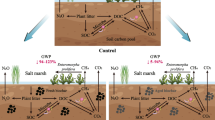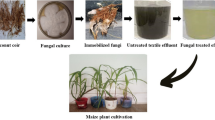Abstract
Compliance with the European Union regulations (European Community 1991) resulted in the construction of numerous secondary treatment Sewage Treatment Plants (STP) in many maritime cities of Greece. Thus, the production of sludge and wastewater dramatically increased and various solutions concerning their disposal or utilization are under investigation. Sewage of these cities, where the activities are limited to agriculture or tourist services is characterized by the lack of heavy metals and toxic substances and the utilization of the STP products in various ways seems unthreatening to the environment. Yet, both wastewater and sludge are characterized by high microbial loads. Water has to be sterilized by chlorination prior to any disposal. Sludge keeps the high microbial load and, although rich in inorganic nutrients, has to be treated carefully.
The effect of sewage sludge application to agricultural soils has been investigated, mostly in industrial countries (Raven and Loeppert 1997; Towers and Home 1997). The effect of treated domestic and industrial effluents on plants have also been investigated (Hooda et al. 1997; Logan et al. 1997; Palacios et al. 1999; Samaras and Kallianou 2000; Weir and Allen 1997).
Respecting the restrictions imposed by the E.U.’s directive (European Community 1986), but also taking into account the exhortation included for further investigation, we launched a project to find out how water and sludge could affect plant crops of great economical importance (Margaris et al. 1995). Corn (Christodoulakis and Margaris 1996) and cotton plants (Tsakou et al. 2001a) cultured in sludge amended agricultural soil were monitored during the culture period of concern to various developmental parameters. A comparison to plants cultured the conventional way led to interesting results (Tsakou et al. 2001a, Tsakou et al. 2001b). Having in mind: a) the global interest for reducing the use of chemical fertilizers, b) the great financial value of plant fibers, and c) the fact that non edible plants are preferred for this kind of experiment, we continued our investigation selecting flax (Linum usitatissimum). Our interest remains focused on the study of the impact that sewage sludge and wastewater have on the phenology, growth, productivity, and heavy metal accumulation of these plants.
Similar content being viewed by others
References
Christodoulakis NS, Margaris NS (1996) Growth of corn (Zea mays) and sunflower (Helianthus annuus) plants is affected by water and sludge from a sewage treatment plant. Bull Environ Contain Toxicol 57: 300–306
Dambroth M, Seehuber R (1988) Züchtung Anbau und Verarbeitung, Stuttgart, Ulmer, p 108
EUROPEAN COMMUNITY (1986) Council Directive 86/278/ECC No L181. Offficial Journal of European Communities, 4/7/1986, Brussels, Belgium
EUROPEAN COMMUNITY (1991) Council Directive 91/271/ECC No L135. Offficial Journal of European Communities, 30/5/1991, Brussels, Belgium
Hoffmann W, Zoschke U (1955) Röntgenmutationen beim Flachs (L. usitissimum L.). Züchter 25:199–206
Hooda PS, McNulty D, Alloway BJ, Aitken MN (1997) Plant availability of heavy metals in soils previously amended with heavy applications of sewage sludge. J Sci Food Agric 73: 446–454
Logan TJ, Lindsay BJ, Goins LE, Ryan JA (1997) Field assessment of sludge metal bioavailability to crops: sludge rate response. J Environ Qual 26:534–550
Margaris NS, Christodoulakis NS, Giourga C (1995) Waste management and water use in the island of Kos, Greece. Insula 3: 36–39
Palacios G, Carbonell-Barrachina A, Gomez I (1999) The influence of organic amendment and nickel pollution on tomato fruit yield and quality. J Environ Sci Health B34:133–150
Raven KP, Loeppert RH (1997) Heavy metals in the environment. Trace element composition of fertilizers and soil amendments. J Environ Qual 26:551–557
Samaras V, Kallianou C (2000) Effect of sewage sludge application on cotton yield and contamination of soils and plant leaves. Commun Soil Sci Plant Anal 31: 331–343
Towers W, Home P (1997) Sewage sludge recycling to agricultural land: the environmental scientist’s perspective. J CIWEM: 126–132
Tsakou A, Roulia M, Christodoulakis NS (2001a) Growth of cotton plants (Gossypium hirsutum) as affected by water and sludge from a sewage treatment plant. I. Plant phenology and development. Bull Environ Contain Toxicol: 735–742
Tsakou A, Roulia M, Christodoulakis NS (2001b) Growth of Cotton Plants (Gossypium hirsutum) as Affected by Water and Sludge from a Sewage Treatment Plant. II. Seed and Fiber Yield and Heavy Metal Accumulation. Bull Environ Contain Toxicol: 743–747
Weir CC, Allen JR (1997) Effects of using organic wastes as soil amendments in urban horticultural practices in the district of Columbia. J Environ Sci Health A32:323–332
Author information
Authors and Affiliations
Rights and permissions
About this article
Cite this article
Tsakou, A., Roulia, M. & Christodoulakis, N.S. Growth of Flax Plants (Linum usitatissimum) as Affected by Water and Sludge from a Sewage Treatment Plant. Bull. Environ. Contam. Toxicol. 68, 56–63 (2002). https://doi.org/10.1007/s00128-001-0219-3
Received:
Accepted:
Published:
Issue Date:
DOI: https://doi.org/10.1007/s00128-001-0219-3




